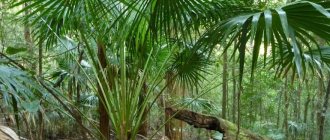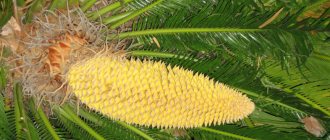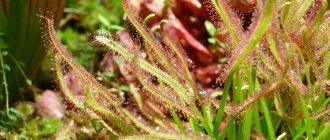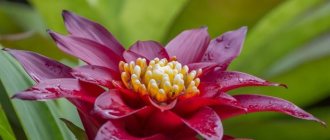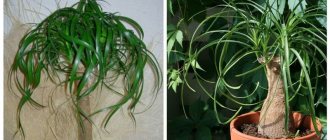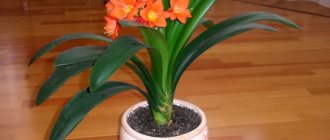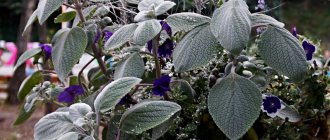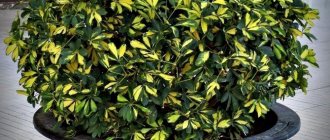Tropical natives are becoming increasingly popular. Their exotic appearance can transform any space. The heroine of the article is one of the most popular representatives of the flora in this area. Belongs to the Arecaceae family. With proper care, it can reach a height of up to 180 cm. The thickness is small, only 3-4 cm. The trunk is bare, with internodes located on it. The pinnate leaves are formed from the central trunk. Most come from the cuttings, a smaller part grows directly from the trunk.
- The leaves are darkening
- Rhizome division
The bamboo palm prefers soft lighting with slight shading. It is best to spray the plant in the evening and in the morning; watering is done after the top layer of soil has dried.
Another name for the culture is Hamedorea. It can have one or more of them (multi-channel). Refers to dioecious species: there are male and female “individuals” that need pollination.
Description
Hamedorea is native to Central America. It is less common in northern South America, Madagascar. The second name of the plant is bamboo palm; the variant mountain palm, neanta, is also sometimes used.
Most species of chamedorea are low-growing or dwarf trees. But representatives of this genus also include vines and shrubs. At home, it is the latter option that is often grown.
The Hamedorea palm has a creeping rhizome from which numerous shoots arise. Over time, they produce new stems, forming dense thickets.
The stems of Hamedorea are bamboo-like, with short internodes, no more than 3 cm in diameter.
At the top of each stem a bunch of leaves is formed, consisting of 5-7 pieces. As the trunk grows, the lower leaves fall off, leaving a light mark on it.
The plates are painted bright green. In most species they are dissected and reach 40 cm in length.
The bamboo palm is a slow growing species. Over the course of a year, it can form 1-2 leaves. But this is a long-lived flower.
With proper care, chamedorea lives up to 40 years.
Therefore, even at home it can reach 1.5 m. Although indoor specimens more readily grow not in height, but in width, producing new stems.
Hamedorea does not contain toxic substances. Cats like this palm tree; they readily gnaw on it. Therefore, pet owners should consider potty placement.
The bamboo palm produces 2 types of flowers - male and female. But on a single specimen only one type of bud appears.
Male flowers are spherical in shape and reddish in color. They are collected in inflorescences located on long peduncles.
Female palm flowers are yellow and orange. They grow singly on stalks.
Hamedorea is not considered a beautifully flowering plant. It is grown for its decorative foliage.
Scientists believe that the bamboo palm exhibits high phytoncidal activity and purifies the air.
Diseases and pests of chamedorea, methods of combating them
Like most plants, palm trees are also susceptible to disease and pest damage. The most common are fungal diseases (fusarium, late blight, pythium), leading to drying out of the green parts and fruits, and rotting of the roots. Causes of such diseases:
- Pest damage,
- Poor or no soil drainage
- Weakened plants.
You can save the flower with fungicides containing menokbez, methyl thiophanate. The frequency of treatment is once every ten days until the vital activity of the flower is completely restored.
Often the leaves of ornamental palm trees are affected by scale insects, mealybugs, aphids, and spider mites.
Fighting mealybugs
The scale insect sucks out the juices of the shoots, which retards the growth of the plant. Leaves affected by scale insects become covered with cobwebs. Signs of damage:
- Falling of ovaries, fruits,
- Cracking of bark on branches and trunk,
- The appearance of sugary sticky discharge.
At the beginning of the disease, it is enough to wash the affected areas with soapy water. You can treat with infusions of tobacco or garlic weekly.
Fighting spider mites
This pest starts on the back of leaves and stems.
Signs of damage:
- The appearance of a web
- The presence of light spots that later acquire a brown color,
- Drying and falling leaves.
The cause of the appearance of mites is stable dry air. The tick does not tolerate high humidity. Therefore, at the initial signs of the disease, remove the cobwebs that have appeared from the leaves and spray regularly.
The plant can be treated with insecticides if necessary.
Popular types of Hamedorea
Types of Hamedorea differ quite greatly in appearance, but require similar maintenance conditions.
Elegance or Graceful
The most popular type of bamboo palm. The plant owes its popularity to its unpretentiousness and original appearance.
Hamedorea gracefula easily forms buds and can bloom all year round. Its inflorescences resemble mimosa.
The leaves consist of 24-28 lanceolate fragments. The height of adult specimens, even at home, exceeds 1.5 m.
Other types
The leaf blades of Ernest-August chamedorea are whole, only at the top they are divided into 2 parts. The maximum height of the plant does not exceed 1.2 m.
Chamedorea metallica has wide and leathery leaves. Like the Ernest-Augusta variety, they are solid, forked at the top.
A distinctive feature of this palm tree is the silvery hue of the leaf blades. This type of chamedorea does not form additional trunks.
The monochromatic chamedorea has feathery leaves and looks very much like an elegant one. But this species is more suitable for greenhouses; it is rarely found in houses.
Hamedorea erupta is a low, willingly bushy palm tree.
Hamedorea stolonifera is easily recognized by its many aerial roots and whole leaves.
Cascade, also called cat palm, is one of the fastest growing species. It is distinguished by many shoots and dark green feathery leaves.
Flower design
Growing is quite simple. This is an indoor plant, however, in the southern regions it can be exposed to the open air, but only in the summer. It is often planted several copies in one pot or in compositions with other decorative foliage plants that have similar requirements. Despite their apparent fragility, chamedoreas grow well in rooms. Known species and varieties: Hamedorea elegans, Hamedorea bridble. It looks especially beautiful if you combine several species in one pot: Hamedorea elegans and Hamedorea bridble; you can plant several plants in a group, but of different heights. Thus, Hamedorea elegans or bamboo palm will look even more attractive. With proper care, they can even bloom. You can combine several similar plants, for example, with howea. Good luck to you.
Hamedorrhea: care at home
Hamedorea is not picky about lighting, but requires spraying and a properly adjusted watering regime.
Lighting and location in the home
The Hamedorea palm is a shade-tolerant plant. Exposure to direct sunlight causes sunburn: brown spots appear on the leaves.
In nature, the palm tree has adapted to life in partial shade or in diffused light. At home, it is even placed near north-facing windows or in the back of the room.
A tub of chamedorea can be kept in the corridor and other places where there is no natural light. It grows well thanks to artificial light sources.
It is enough to illuminate this shade-tolerant palm for 10-12 hours. And the illumination level may not exceed 1000 lux.
Buying a plant
Hamedorea can be found in flower shops - often it is a small bush with many basal shoots. It is difficult to find a large palm tree because it grows slowly and is therefore very expensive.
When choosing a plant, you need to pay attention to the leaves - they should not be dull, dried out or brown at the ends. A new plant brought home should be left to rest for several days so that it gets used to the new environment.
After 7-10 days it will be possible to start dividing the bush and replanting.
Transfer
Hamedorea is replanted in the spring. Young specimens need to increase the pot every year.
Mature palm trees only need to update the soil. They change the top layer of soil. You can replant once every 5 years or less often if the roots do not start to poke out of the drainage holes.
A newly purchased palm tree is replanted almost immediately (maximum 12-15 days). The season does not matter.
Priming
Hamedorea is planted in special soil for palm trees. Soil mixtures sold in flower shops are peat-based and already contain perlite and sand. They can be enriched with charcoal to prevent infections.
The soil for chamedorea should be neutral, pH 6-6.5.
When preparing it yourself, peat, humus and turf are used as components in equal proportions. This mixture is loosened with sand in an amount of ⅙-⅕ of its volume.
Drainage is laid out at the bottom of the pot. It should occupy ¼ of the height of the container.
Pot
During a planned transplant, the diameter of the chamedorea pot is increased by only 2-3 cm. You should not take the container “for growth.” This will lead to acidification of the soil.
For a bamboo palm, the material used to make the pot is not important. But for tall adult specimens, ceramic or wooden tubs are often preferred, because they are more stable.
However, you should not take a container that is too deep. The diameter must be greater than the height. The rhizome of Hamedorea grows in breadth.
Recommendations for transplantation
A healthy chamedorea needs to be replanted by transshipment. Before removing the plant, tap the pot on all sides to make it easier to remove the palm tree.
Sequence of actions during transplantation:
- Hamedorea is removed from an old pot.
- The earthen ball is inspected. If there is no suspicion of root rot, it is not destroyed.
- The plant is placed in the center of the new pot.
- Fill the voids with earth.
- Water the soil and place the palm tree in the shade.
If Hamedorea is replanted because the old soil has turned sour or the roots have begun to rot, the soil must be cleaned as much as possible. To do this, use a wooden stick or wash the roots under water.
Damaged areas are cut off, healthy areas are treated with fungicides.
You can see how chamedorea is transplanted after purchase in the video below.
Features of caring for rapis
This plant does not require complex procedures; care includes providing certain conditions and quite standard procedures:
Lighting
Rapis is one of the most light-loving palm trees, which is not harmed even by direct sunlight falling on its leaves in small quantities. However, she feels best when in partial shade.
To ensure that the crown of the bush is beautiful and uniform, it is recommended to periodically rotate the container with the plant. But sudden changes will not benefit the palm tree, therefore, it should not be moved to areas with different lighting.
The palm needs time to adapt, so it is initially better to place a newly acquired pet in a shaded place, gradually adding light.
Air temperature
The optimal indicator for rapeseed is +20 - +22 degrees; in summer it is recommended to move the plant outside. If the latter is not possible, care must be taken to regularly ventilate the room.
In winter, a “cold winter” is useful for the palm tree - keeping it in a room with a temperature of +10 - +16 degrees. This “rest” has a positive effect on the appearance of the plant. But if this is not possible, then the palm tree will winter well in an ordinary apartment.
Humidity indicators, watering and fertilizing
Watering is perhaps the most difficult aspect of caring for this fan palm. The difficulty is that both overwatering and drying out of the soil are harmful to it. And at the same time, the plant should be provided with a moist substrate, which should always remain that way.
In summer, rapis is watered frequently and abundantly; in winter, if the palm tree experiences a “cold winter,” the amount of watering is significantly reduced. For these purposes, you should use pre-settled, warm water.
Most experts agree that rapeseed does not need air with high humidity. However, it benefits from regular spraying, especially in the summer and in dry air. In winter, additional moistening of the leaves is not required.
It is recommended to feed the palm tree with complex mineral fertilizers, which are applied to the soil 1–2 times a month. This should be done in autumn and summer.
Correct transplant
It is better not to disturb or replant an adult palm tree unless absolutely necessary. It is enough for her to periodically replace the top layer of the substrate.
But a young plant that has not reached its maximum height will most likely require replanting. Experienced flower growers advise against a complete transplant, but to carry out transshipment, moving the pet from a smaller container to a larger one.
For rapeseed, it is better to choose a pot with low sides, but wide, since this palm tree has a superficial root system. And besides, in such a container it is easier to avoid acidification of the soil.
The easiest way is to purchase a ready-made mixture intended for palm trees. You can also prepare it yourself by combining the same amount of sand, humus, peat, turf and leaf soil.
You can improve the composition of the soil by adding a little crushed peat moss or hydrogel beads. This will allow you to water the palm tree less often and also prevent the soil from drying out. In addition, the pot must be equipped with good drainage.
Rapis palm propagation
The most popular method for this plant is root division. Usually, this procedure is carried out during transplantation, so as not to disturb the palm tree again.
You can also use the seed growing method. But, as in the case of other palm trees, such planting material germinates very slowly - the first sprout appears no earlier than after 10–12 weeks.
Pest Control
Most often, such ornamental palm trees are affected by pests such as scale insects and spider mites:
- The scale insect is a harmful insect that attaches itself to young shoots and sucks the juice from them. To combat the parasite, it is recommended to treat the plant with soap, alcohol or garlic solution, and then use insecticidal preparations.
- Spider mite - you can find out that it has infected a plant by finding the finest cobwebs on a palm tree. The tiny tick itself is very difficult to see with the naked eye. To treat palm trees, you can use the traditional method - treatment with onion solution or chemicals.
Rapis is an interesting ornamental plant that goes well with other green “residents” and is quite self-sufficient in itself. It is better to choose a low-growing variety for the neighborhood, and a tall one as the only “inhabitant”.
Reproduction
Palm trees reproduce primarily by seeds. But the vegetative method is also suitable for chamedorea.
Seeds
Only fresh seeds collected no more than a year ago are suitable for germination. If they are obtained at home through artificial pollination, they should be planted immediately after collection.
Step-by-step instructions for growing Hamedorea from seeds:
- The fleshy membrane (apex) is removed.
- The seed is soaked for 5 days in clean water.
- Scarification is carried out (the hard shell of the seeds is scratched with a file or sandpaper).
- Place the seeds on a damp mixture of peat and sand, do not bury them or sprinkle them on top. The part of the seed where the shell was damaged should be in contact with the ground.
- The pot with the seed is covered with film.
- The greenhouse is ventilated every day and the soil is not allowed to dry out.
Hamedorea seeds are germinated at a temperature of 25°C. Each seed is planted separately. It is convenient to use 200 ml cups.
Depending on the quality of the seeds and conditions, seedlings appear in 2-8 months.
Frequently asked questions about growing Hamedorea
The leaves are turning yellow. Why?
Even with conscientious care, the leaves of the flower periodically turn yellow. Don't rush to trim them if there is still a lot of green part on them. One of the reasons may contribute to yellowing of vegetation:
- Incorrect location
- Plant age
- Diseases,
- Pest infestation.
Yellowing of leaves is observed in palm trees with age. They need to be cut close to the stem, leaving a small petiole, which will then dry completely. During transshipment, these petioles are carefully cleaned, and the palm tree looks fresh again.
The cause of yellow leaves may be the diseases and pests discussed above.
An incorrectly chosen location also leads to yellowing of the foliage, especially if the plant is located in an area of direct rays. In the sun, it is not the flower itself that overheats, but the container and with it the substrate and roots.
Why do the leaves of Hamedorea dry out?
Sometimes drying out of the tips of the flower leaves occurs. What are the reasons for this?
- Insufficient watering
- Dry air
- Flooded soil, rotten roots (withered young foliage appears, leaf tips dry out);
- An overly dense substrate that retains moisture for a long time. In this case, the roots are constantly in a damp environment.
By following agricultural techniques and rules for caring for palm trees, it is not difficult to eliminate these manifestations.
Hamedorea diseases
The most common disease of bamboo palm is root rot. It is caused by overwatering of the plant, stagnation of water in the pan, especially when kept at a low temperature.
A sign of the disease is the wilting of the plant. Its stems and leaves droop, yellow spots appear on them, and over time the plates begin to turn black.
To save the palm tree, it is replanted with a complete replacement of the soil. In this case, damaged roots are cut off, unaffected roots are treated with fungicides (Fundazol, Fitosporin, etc.) for prevention.
After replanting, reduce the frequency of watering and add fungicides to the water for the first time.
How to water
- Watering. Frequently as the plant prefers moist soil, but avoid waterlogging. We constantly spray to bring the conditions in the house closer to natural. In summer, plants are watered abundantly, preventing the earthen clod from drying out. In order to saturate the soil with moisture, the bamboo palm is placed in a container of water - this is enough to do once a week. In winter, the plant is watered less frequently and not as abundantly. Therefore, in the autumn-winter period, watering can be reduced, but you should constantly ensure that the soil never completely dries out.
- Feeding. It is recommended to feed with liquid complex fertilizers, which are diluted in water for irrigation. The bamboo palm is very responsive to feeding. We fertilize from spring to autumn, once every two weeks is enough.
Pests
Of the pests, chamedorea is most often attacked by spider mites. As a result of its appearance, the leaves dry out, a white coating forms on their underside, and light yellow spots appear on the top.
This pest becomes active at low air humidity. Therefore, regular spraying is also a prevention of infection.
This is what pests of indoor plants look like: spider mites, mealybugs and scale insects
Less commonly, chamedorea is attacked by scale insects (dark spots appear on the leaves) and mealybugs (a coating resembling flour is visible).
When insects appear, they are removed mechanically - washed off with a shower, collected by hand, etc. After this, 3-4 treatments are carried out with insecticides (Fitoverm, Akarin, etc.).
Plant pests, or why palm leaves dry out
It is always more difficult to combat fauna parasitizing a plant than to prevent its appearance. Both pests and diseases are always observed more often on weakened green pets than on healthy ones with strong immunity.
Scale insects, mealybugs, aphids, thrips and spider mites are found on palm trees; whiteflies can be less commonly seen on the underside of foliage. With the appearance of mites, the foliage turns yellow and dries very quickly. The attacks of many pests can be avoided by regularly washing the leaves with water. Neither mites, nor scale insects, nor scale insects like such procedures. For prevention, you can wash the plant with soapy water once a month.
If pest colonies have increased as a result of lost time, appropriate chemicals are used and the affected plant is treated repeatedly.
Other growing problems
If chamedorea has lost its decorative appearance, this is not always a sign of disease or pest attack. The most common problems and their causes are listed in the table below.
| Problem | Probable Cause |
| The tips of the leaves dry out, but the plates do not turn yellow | Insufficient air humidity |
| The leaves are curling | Low temperature Draft |
| Leaves turn yellow | Watering with hard water Excess sunlight |
| Palm tree growth has stopped | Nutrient deficiencies |
| The tips of the leaves have turned brown | Overflow |
| The leaves are darkening | Temperature too high or low |
| Light spots on leaves (no plaque) | Lack of iron in the soil |
| Brown spots on leaves | Burn from the sun or contact with heating radiators |
| Gray coating that can be easily washed off the leaves | Water is too hard |
If the lower leaves gradually dry out, this is a normal process of crown renewal. It is thanks to him that the palm tree acquires its characteristic appearance.
Opinion of an expert from the channel “Flowers in the House. Indoor Plants” you can learn about the problems of growing chamedorea from the video below.
A sign of a problem is that several plates dry out at once.
This may equally likely indicate that the chamedorea is not being properly cared for at home, or that the palm tree has been attacked by pests or is infected.
White coating, drying tips, blackening petioles - problems and their solutions
Some problems that appear on a palm tree are not related directly to the plant, but to the soil in which it grows.
Table: soil problems
| Problems | Symptoms | Necessary measures |
| Stopping growth | Weak or absent growth | The soil temperature should be maintained at +25 degrees, since at lower temperatures the activity of the root system slows down and the absorption of nutrients from the soil decreases. |
| Nutrient deficiencies | Chlorosis (fading) of leaves |
|
| Leaf burn | Brown spots along the edge of the leaf blade | The soil needs to be replaced (full or partial), and watering is reduced at the same time, since marginal leaf burn occurs due to excessive dampness and poor root aeration. |
| Magnesium deficiency | Lower leaves become lighter (chlorosis) |
|
| Copper toxicity | Elliptical spots on leaves |
|
Also, loss of attractiveness can be caused by errors in care and maintenance.
Table: yellowing leaves and other consequences of improper maintenance conditions or care errors
| Problem | Possible reasons | How to fix the situation |
| Brown spots on leaf blades |
|
|
| Tips of leaf blades dry out | The room is too hot and dry. This happens especially often during the heating season. |
|
| Leaf blades gradually turn yellow |
|
|
| The lower leaves dry out | This is a natural process caused by the age of Hamedorrhea | Senescence can be delayed by spraying the plant more often |
| Leaves become darker in color and wilt | Room temperature too low | Move the chamedorea to a warmer place |
Treatment of palm trees for diseases and pests
Under good maintenance conditions and with the correct watering regime, chamedorea is practically not affected by pests and diseases, but with excessive moisture or dryness it can be bothered by shield aphids, spider mites, mealybugs, and in dampness the palm tree can develop root rot.
Table: how to treat a palm tree for lesions
| Diseases and pests | Signs | Reason for appearance | Treatment and prevention measures |
| Root rot |
| Cold indoor air and too much watering |
|
| Fusarium wilt |
| The room is too humid |
|
| Mealybug | A cotton-like cobweb coating appears on the leaves. | The air in the apartment is too dry, the plant does not have enough moisture |
|
| Spider mite |
| Consistently dry indoor air |
|
| Shield aphid (scale insect) |
| Insufficiently humid air |
|
Photo gallery: diseases and pests of Hamedorea
A sign of mealybug infestation is a cotton wool-like coating on the leaves.
Spider mites appear on chamedorea due to dry indoor air
Due to the activity of shield aphids, the leaves turn pale and become limp.
A sign of root rot are black spots on the roots and shoots
Signs and superstitions associated with the bamboo palm
Esotericists believe that only kind, honest people can have chamedorea. It will not benefit anyone who harms others.
Popular beliefs associated with the bamboo palm:
- chamedorea feeds its owner with energy and improves sleep, and also helps to achieve success in business, sports, and creativity;
- darkened leaves indicate the presence of evil spirits and damage in the house;
- the appearance of this plant in the house helps to extinguish conflicts and quarrels in the family;
- chamedorea fights off energy vampires.
Photo of the plant and its flowers
Look at the photo to see what a bamboo palm usually looks like.
And also a photo of blooming chamedorea.
In this photo you can take a closer look at its flowers.
